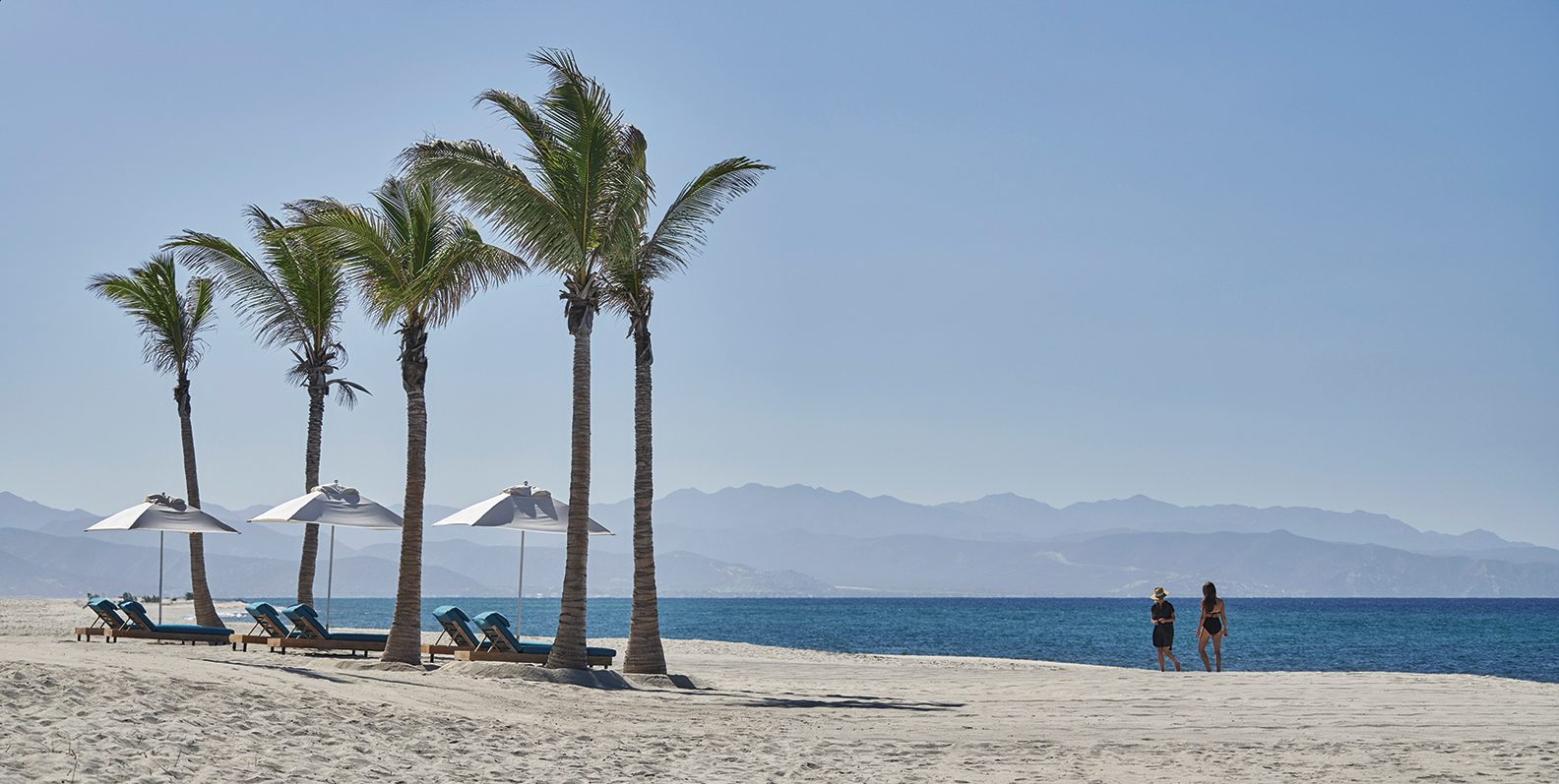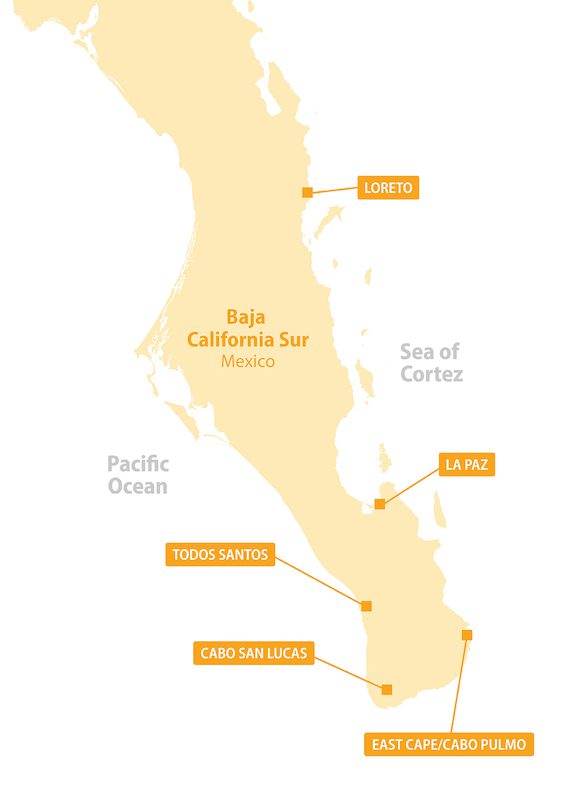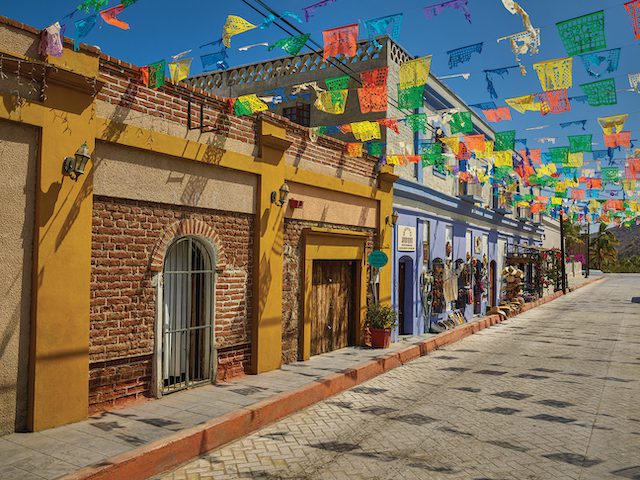
27 Sep Baja Beyond Fish Tacos
A road trip exploring Mexico’s Baja California Sur goes big on uncrowded beaches and aquatic life, pueblos magicos, refreshing mezcals and eclectic eats
 The call of Cabo is loud and clear, a siren song for Steinbeck and Cousteau and those of us living high in the Sierra Nevada, especially during the cooler months.
The call of Cabo is loud and clear, a siren song for Steinbeck and Cousteau and those of us living high in the Sierra Nevada, especially during the cooler months.
For those seeking a little something beyond the usual beach resorts and jumbo margaritas of Los Cabos (Cabo San Lucas and San Jose del Cabo), a road trip farther afield along the peninsula of Baja California Sur is an accessible and easy adventure big on beautiful beaches and rocky coves, crystalline waters teeming with marine life, authentic urban experiences and pueblos magicos bringing imaginative eats and original art—and many a well crafted and chilled mezcalita, the margarita’s cousin mixed with mezcal, also made from the agave plant.
Occupying the southern half of the Baja California peninsula, the state of Baja California Sur is bounded to the north by the state of Baja California, to the east by the Gulf of California (also known as the Sea of Cortes) and to the west and south by the Pacific Ocean. The Sierra de La Laguna mountain range, a UNESCO-designated global biosphere reserve, runs down the middle like a rocky spine, reaching nearly 7,000 feet in elevation.
Highways are narrow but good, paved, with some toll roads a better option. Local advice suggests not driving after dark—to avoid not crime, but the potholes and errant livestock on smaller roads and streets.
Before leaving the Cabo area, refuel at Flora’s Field Kitchen, part of a property slightly north of San Jose del Cabo that includes a 25-acre working farm. Founded by Bay Area expats Gloria Wallace and Patrick Greene nearly 15 years ago, the Michelin-mentioned and much-Instagrammed oasis serves seasonal, field-to-table plates in an airy, rustic-chic dining hall with patio seating and live music. The fresh Northern California–Italian-centric menu features house-made burrata, black pepper fettuccine with lemon and Parmesan, porchetta panini and over a dozen Neapolitan-style wood-fired pizzas; cocktails include a refreshing smoky mezcal and hibiscus combo. Flora Farms also offers boutiques, cooking classes, farm tours and a spa.
Todos Santos
About an hour from Cabo San Lucas via Highway 19, Todos Santos, which means “All Saints,” was founded as a mission in 1724. Designated as one of Mexico’s pueblos magicos—destinations that offer visitors “cultural richness, historical relevance, cuisine, art crafts and great hospitality”—the cobblestoned colonial town has long attracted surfers and, more recently, a wider eclectic selection of boho-chic, artistic and foodie sorts attracted to its less hectic, chill vibe.
Yes, there is a Hotel California here, but no, it’s not that one. But you can check out any time you like at the Guaycura Boutique Hotel Beach Club & Spa, which offers 14 rooms in a modernized nineteenth-century brick building in the heart of the old town. Catch a cocktail and sunset at its rooftop pool and Sky Bar Lounge or head to the nearby beachfront El Faro Ocean Club, where guests have privileges at the pool, restaurant and beach. Brave a sandy uphill drive and be rewarded with panoramic views and a full bar and restaurant at El Mirador at the top.

Colonial Todos Santos’ cobblestoned streets are lined with many small art galleries and boutiques, photo courtesy visitloscabos.com
The contemporary Oystera, which also gets a Michelin nod, is housed in town in a grand Victorian-style brick, steel and glass structure that was once a sugar refinery, with seating inside around a bar surrounded by art galleries and outside on a view terrace. Oysters with Baja-style ponzu sauce, along with other seafood from octopus carpaccio to charred aguachile, can be paired with a bar full of bubbles and wines from around the world proffered by experienced sommelier Jose Antonio Artigas.
Also getting Michelin-worthy: DUM, a restaurant located along a path through what looks a bit like a jungle to a haven-like space, where chefs and couple Aurelien Legeay and Paulina Noble change the a la carte and tasting menus every new moon.
Benno, located in the Hotel San Cristobal at Playa Punta Lobos, serves ceviche, house-made pasta and dishes such as fish en mole verde in a chic and breezy setting.
On the edge of town, Jazamango’s chef-owner, Javier Plascencia, uses locally sourced ingredients in seafood, meat and pizzas, all served in a lovely open-air garden setting. Try here wood-grilled chocolate clams, a regional specialty so named not for their flavor but for their color, cooked with butter, green chile, beef jerky from Guanajuato, soy and fermented bean paste.
Surf and swim safely at the broad beach of nearby Pescadero’s Los Cerritos, where you can rent a board or take a lesson and meander barefoot into the sandy-floored Barracuda Cantina for grilled or battered and fried fish and shrimp tacos, smoked fish quesadillas, cocktails and ice cold beer.
East Cape/Cabo Pulmo
Head north along Highway 1 to the East Cape on the Gulf of California, a two-hour drive skirting the jagged Sierra de la Laguna. Relatively undiscovered and definitely more rural, the calm, clear, swimmable waters contrast with the rocky shores and riptides of Cabo San Lucas.
Designated a UNESCO World Heritage site, with waters Jacques Cousteau called “the aquarium of the world” for its 800-some species of marine life, Cabo Pulmo National Marine Park boasts one of the largest and most diverse coral reefs in North America. Five of the world’s seven endangered species of sea turtles and a large variety of sharks find refuge here, along with whales—lots of whales—dolphins, sea lions and rays. Snorkeling, kayaking and low-impact diving are the best ways to jump headlong into the aquatic wonders here.

Colorful artwork found around Todos Santos includes large-scale metal sculptures, photo by Sue Rock
Cabo Pulmo sits at the end of a difficult drive down shifting sandy roads and offers modest off-the-grid accommodations. Instead, splash out for a stay at the Four Seasons Resort & Residences Los Cabos at Costa Palmas and travel to Cabo Pulmo by boat, a 50-minute ride aboard a sleek and fast Spearo 6 boat that departs from the resort’s marina and continues seamlessly on a truly eye-popping guided snorkel tour inside the park.
Located in an ambitious 1,500-acre development called Costa Palmas on the East Cape, the Four Seasons boasts 2 miles of pristine beachfront and 141 elegant guest rooms, including 23 suites, with plunge pools and ocean views, along with a Robert Trent Jones II golf course, spa and wellness center, gym, six pools, kids club and complimentary bikes.
Nine excellent restaurants offer seasonally changing menus. Produce from the region is famous thanks to the rainfall off the Sierra de la Laguna mountain range; Costa Palmas has 18 acres of orchards and gardens whose crops are used on-site at the various restaurants. The resort also works with local purveyors, farms and fishermen who make daily deliveries to the property.
At chef-restaurateur Costas Spiliadis’ Estiatorio Milos, Med meets Mexican in a chic beachside dining experience (other locations include New York, Athens, Las Vegas, Miami, London and Dubai).
Zest has one table that seats up to 12 guests and offers a fine dining nine-course tasting menu from executive chef Fabio Quarta.
At the al fresco Limon, located in a peaceful twinkly light lemon garden, farm-to-table dishes such as bluefin tuna with orange segments and tomato gazpacho and soy agave honey pork ribs with plantain puree come off the grill and out of the wood-fired oven. Additional dining options include poolside Baja-style brasserie Casa de Brasa and cevicheria and sushi bar El Puesto. Tequila tasting and cooking classes are offered as well.
Two neat things to note: General manager Borja Manchado loves music and has created the cool soundtrack that plays in the restaurants and around the resort. And August through October you can participate in a nightly baby turtle release (each year more than 300 olive ridley nests are relocated and planted in safe areas within the Costa Palmas property, where they are protected and tracked).

Yes, fish-and shrimp-tacos are on the menu throughout Baja California Sur, especially in La Paz, casually known as the fish taco capital of Mexico, photo by Sue Rock
La Paz
Onward to the fish taco capital of Mexico. A two-hour drive north leads to La Paz, a city of some 250,000 that serves as the capital of Baja California Sur.
Famous for its seafront promenade, El Malecon features many humble, family-friendly open-air eateries like Mariscos los Laureles, which serves ceviche and cold beer with a side of mariachi.
Get your battered fish and shrimp tacos, crab-and-stingray-stuffed tacos dorados and smoked marlin empanadas at Taco Fish La Paz. Or try McFisher’s famous filete imperial de camarón—bacon-wrapped shrimp stuffed with cheese that’s grilled and finished with a cilantro sauce.
La Paz has a culinary flipside in the elegant NEMI, serving contemporary Mexican cuisine in a modern and sleek setting. The artfully presented tasting menu paired with wines from Mexico’s nascent vineyards in northern Baja’s Valle de Guadalupe might include a black aguachile, sea scallop and caramelized avocado or cheese tamale, with mole, huitlacoche, foam cheese and ash.
Tatanka Baja Fish & Steakhouse, with its open fire and indoor and outdoor seating, is also a popular La Paz stop.
Sportfishing is big business here, with the busy, recently renovated marina packed with private and commercial charter boats rigged for chasing game fish from sailfish to wahoo. During winter months, excursions to swim with gentle giant seasonal residents, whale sharks, are a bucket-list item for many visitors. Several nearby beaches include the white sands and crystalline waters of Playa Balandra, whose mushroom rock is a local landmark; for those looking for more remote adventure, a day trip out to Espiritu Santo island provides plenty of options for swimming and snorkeling plus hiking amidst interesting rock formations.
To stay central to all the action, reserve a room at the newish Hotel Catedral la Paz, which is named for and overlooks the nineteenth-century Nuestra Señora de La Paz Cathedral and its plaza.

Loreto grew up around the colonial Misión de Nuestra Señora de Loreto, photo by Sue Rock
Loreto
You can head back to Cabo to make it a round trip, or push on up to Loreto, located on the Gulf of California a four-hour drive north. Baja California’s first Spanish colonial settlement was founded in 1697, its Misión de Nuestra Señora de Loreto anchoring the start of El Camino Royal, the historic corridor connecting the Spanish missions that ends in Sonoma, California. The city served as the capital of Baja California until 1829 and is now designated a pueblo magico.
The waters of Bahia de Loreto National Park are dotted with rugged, uninhabited islands easily visited by panga boat. Isla Coronado, the remnants of an old volcanic cone and now protected wildlife refuge, is the most popular with its rocky outcrops and sheltered bays.
Farther afield, Danzante is home to a variety of waterfowl, including the blue-footed booby, found in only a few locations worldwide.
The waterfront Hotel La Mision de Loreto, a contemporary European-Mexican hacienda-style spot, is close to the marina where tours depart and near the old town, whose pedestrian-friendly cobblestone plaza full of shops and open-air restaurants has grown around its namesake church. The colorful, long-running Mi Loreto serves dishes like grilled filet mignon in black mole sauce, along with classics like chili rellenos and chicken enchiladas.
If pizza, burgers and freshly brewed beers like El Bandito Black Stout or Blood Orange Ale sound better, head for El Zopilote Brewing across the square.
Ready to book your trip? Look for air connections via Los Angeles, Phoenix and Dallas. Baja California Sur’s many delightful and delicious charms await.
For some extra special local experience, TQ Food & Wine Editor Susan D. Rock recommends a Baja Sur road trip overlapping with Dia de Los Muertos celebrated on November 1 and 2.




No Comments